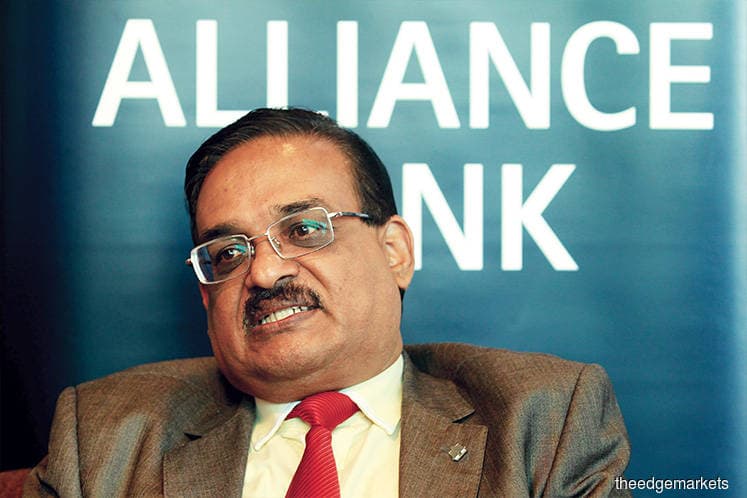
This article first appeared in The Edge Financial Daily on November 13, 2017
KUALA LUMPUR: Higher inflation, unemployment and high household debt-to-gross domestic product (debt-to-GDP) may drag down private consumption, the biggest contributor to Malaysia’s GDP growth, said Alliance Bank Bhd chief economist Manokaran Mottain.
Highlighting the recent increase in fuel prices, he predicted that inflation is likely to grow even higher in the coming months as Brent crude oil prices have hovered near their two-year high, above US$60 (RM251.40) per barrel.
“November may see an inflation rate of up to 5% ... it will definitely be higher than [in] October, which is expected to exceed September’s inflation rate [of 4.3%],” Manokaran said in an interview.
Last Thursday, the retail price of RON95 climbed seven sen to RM2.31 per litre, while the price of RON97 increased six sen to RM2.60 per litre, the highest levels seen since the introduction of the weekly fuel price system in March this year. Diesel too rose three sen to RM2.20 per litre. The increase in fuel prices has been shown to drive up the consumer price index (CPI) in recent months (see chart).
Manokaran recommended the introduction of targeted fuel subsidies for the bottom 40% of Malaysia’s income group as a solution, using the current Bantuan Rakyat 1Malaysia database to identify recipients.
Noting that consumers spend an average of 20% to 25% on transportation, he said higher inflation prices, coupled with low income growth, would result in insufficient disposable income to maintain high levels of consumer spending.
“That is why our GDP growth forecast of 5% for 2017 is more conservative than the government’s, which is between 5% and 5.5%,” Manokaran explained.
In its Economic Report 2017/2018, the finance ministry said private-sector expenditure is expected to grow by 7.3% and contribute 72.9% of GDP.
On the subject of low income growth, Manokaran highlighted easy access to foreign labour as a contributing factor to stagnant wages.
“It is also not true that Malaysians are not productive [or] unwilling to work,” Manokaran stressed. He also noted that unemployment, which is especially high among youths, is another potential drag on consumer spending.
According to data from Bank Negara Malaysia, inflation remained stable at 3.4% in the first half of 2017, compared with the 2016 unemployment rate. However, youth unemployment in 2016 was nearly three times the national unemployment rate at 10.5% in 2016.
Meanwhile, despite the decline in household debt-to-GDP to 85.6% as at mid-2017 versus 88.4% as at end-2016, Manokaran noted that this may still weigh on private consumption.
However, the household indebtedness largely consisted of housing debts and not personal or credit card loans, he said. Prudential measures by the government and central bank, which had reduced loan exposure to non-residential properties, vehicles and securities, are to be commended, Manokaran added.
On the subject of Malaysia’s fiscal deficit target of 2.8% in 2018, he said while this is likely to be achieved, doggedly keeping to the targeted balanced budget by 2020 may not be in the best interest of the country if it comes at the cost of development expansion.
“The government seems to be trying to keep to its fiscal deficit [target] by tightening development expenditure — that is not a good thing because development expenditure is a multiplier,” Manokaran said.
Under Malaysia’s Budget 2018, only 17.3% or RM46 billion of total expenditure is allocated to development, compared with 25% in Singapore’s Budget 2017, he noted.
While the sum allocated is the same as Budget 2017, the portion has been trimmed from 17.6%, though total spending grew to RM280.25 billion from RM260.8 billion to accommodate higher operating expenditure, which climbed to RM234.25 billion (83.6% of total expenditure) from RM214.8 billion (82.4%).
He added that the government was not spending enough on development expenditure in order to fulfil targets set out in the 11th Malaysia Plan, which had allocated RM260 billion to development expenditure between 2016 and 2020.
Separately, Manokaran stressed that the government should play a facilitating role in the affordable housing market instead of competing with developers to offer affordable housing.
The main problem, he said, was that supply was not meeting demand.
“The success rate of existing programmes is too low,” he added, reiterating his recommendation that a central agency be established in order to oversee the sale of affordable homes.
Meanwhile, existing rent-to-own schemes should continue to be supported, he said, adding that they are particularly suitable for fresh graduates and first-time homeowners.